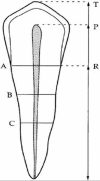Application of the Kvaal method with cone beam for the determination of a local formula for the age estimation of adult African melanoderma subject, Côte d'Ivoire
- PMID: 35499532
- PMCID: PMC10228187
Application of the Kvaal method with cone beam for the determination of a local formula for the age estimation of adult African melanoderma subject, Côte d'Ivoire
Abstract
Background: Age estimation by invasive dental methods is a destructive, costly and time-consuming approach, whereas, age estimation methods using dental radiographs are simple, non-destructive and provide reliable information. Age estimation by the Kvaal radiographic method has proven to be a reliable method, but possible ethnic variations may limit its uses in other populations. The objective of this study was to reproduce the original Kvaal method with CBCT for the estimation of the age of the adult melano-African subject in Côte d'Ivoire, in order to propose an age estimation formula, specific to our study population, by taking into account the measurements of tooth and pulp ratios.
Methods: A cross-sectional study used 102 radiographic data from a CBCT Planmeca® examination in a private dental clinic in Abidjan. It was data from subjects of at least 18 years of age. Dental measurements in length and width of the entire tooth, root and pulp were performed on maxillary central incisors and the different ratios were calculated according to the Kvaal method. The correlation between age and ratios was also assessed. Age estimated using the Kvaal formula was compared to the chronological age. A linear regression equation was developed using ratios and age predictive factors to evaluate the accuracy of the Kvaal formula.
Results: In all, a total of 102 radiographs of 102 subjects, of whom 55 (53.9%) were females, were analyzed. The median age was 51 years (inter-quartile range [IQR] 41- 58). Using the Kvaal formula, the Standard error of the estimated age was higher in the African melanoderma population compared to the Kvaal population. The new formula derived from that of the Kvaal formula was developed and applied to our study population (Age = 84.7- 114.2 (M) - 29.4 (W - L) gave more than double the standard error of estimated age by Kvaal (26.03).
Conclusion: Our study showed that the measurements made by Kvaal are reproducible with CBCT and there is a correlation between age and the dental parameters studied. However, the age estimation formula determined by Kvaal et al. is not valid for African melanoderma subjects living in Côte d'Ivoire.
Conflict of interest statement
The authors declare that they have no conflict of interest.
Figures
References
-
- Adams CMT. A Pathologist’s Guide to Forensic Odontology Identification. In: Rutty GN, editor. Essentials of Autopsy Practice. Springer London; 2013 [cited 2017 ]. p. 135–49. Available from: http://link.springer.com.gate2.inist.fr/chapter/10.1007/978-0-85729-519-4_6 - DOI
-
- Kvaal S, Solheim T. A non-destructive dental method for age estimation. J Forensic Odontostomatol. 1994;12(1):6–11. - PubMed
MeSH terms
LinkOut - more resources
Full Text Sources


